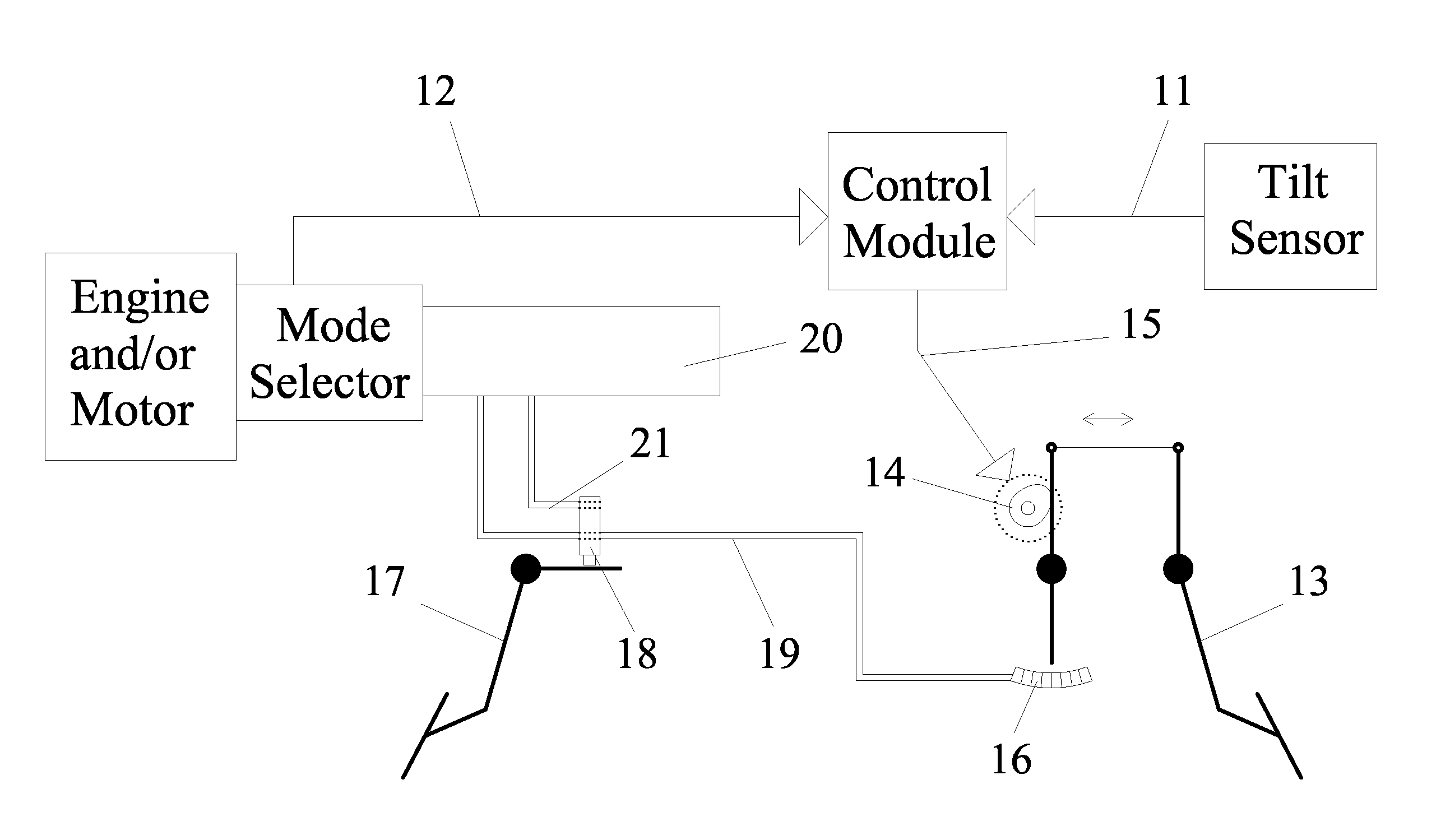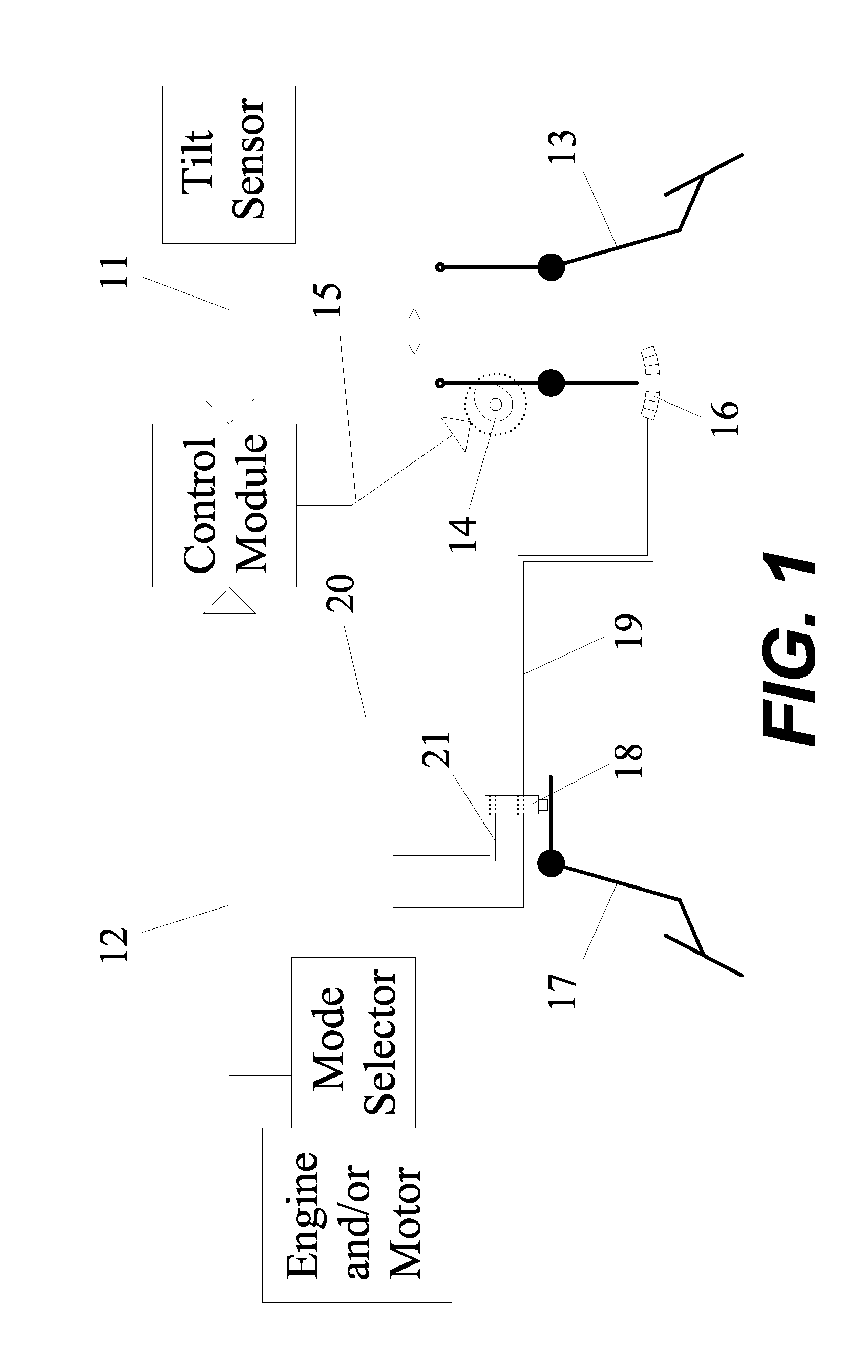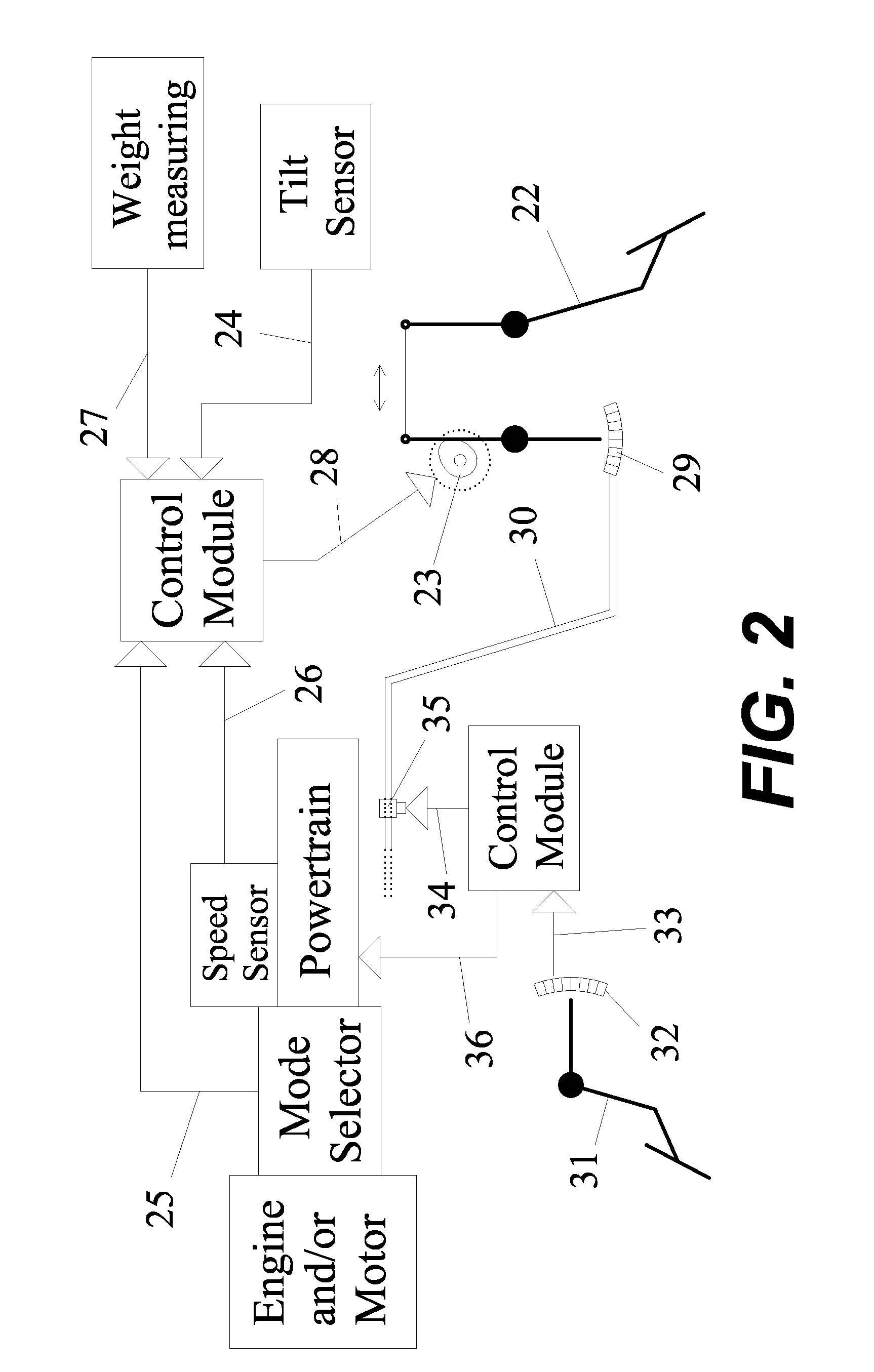[0010]The present invention provides an anti-rollback control system for use in a motor vehicle, to prevent undesired rolling of said vehicle on launching it on an incline, with said anti-rollback control system being simple to design, economic to manufacture and maintain, and having a relatively
simple mode of action which makes it less prone to malfunctions during operation.
[0012]Accordingly, in a motor vehicle having a powertrain that includes an ICE (
internal combustion engine) and / or an
electric motor, and an accelerator pedal that is mechanically incorporated with at least one position-sensing electronic device, with the amount of fuel supplied to said ICE and / or the amount of
electric power delivered to said
electric motor, and hence the amount of mechanical power generated by said powertrain, being a function of the position of at least one movable component of the said at least one position-sensing electronic device, the present invention provides an anti-rollback control system for preventing undesired rolling of said motor vehicle on beginning / resuming the movement of the vehicle after stopping it on an incline.
[0016]In yet another feature, the said anti-rollback control system further comprises a brake pedal actuated device constructed and configured to cause closure of an electrical circuit connected to at least one component of the vehicle's powertrain once the brake pedal reaches a predetermined position, with the said component of the vehicle's powertrain being constructed and configured to cause at least one component of the vehicle's powertrain to move to its idle operating position once the said electrical circuit is closed. In a preferred embodiment, the brake pedal actuated device is an electrical switch constructed and configured to close the said electrical circuit connected to at least one component of the vehicle's powertrain once the brake pedal reaches a predetermined position. In another preferred embodiment, the brake pedal actuated device includes a first brake pedal actuated electrical switch; a second solenoid actuated switch; and a second electrical circuit that connects the first brake pedal actuated electrical switch to the second solenoid actuated switch, with the first brake pedal actuated electrical switch being constructed and configured to close the said second electrical circuit once the brake pedal reaches a predetermined position, and with the second solenoid actuated switch being constructed and configured to close the said electrical circuit connected to at least one component of the vehicle's powertrain once the second electrical circuit is closed. In yet another preferred embodiment, the brake pedal actuated device comprises a
position sensor that detects a position of the brake pedal and generates signals accordingly; a control module; and a solenoid actuated switch included within the said electrical circuit, with the said control module being constructed and configured to receive the signals generated by said
position sensor, process said received signals, and send instructions to said solenoid actuated switch to close the said electrical circuit connected to at least one component of the vehicle's powertrain once the brake pedal reaches a predetermined position. This feature enables moving at least one component of the vehicle's powertrain to its idle operating position when the vehicle brakes are applied.
[0017]In another feature, the said anti-rollback control system further comprises a pressure-activated device that detects the
hydrostatic pressure of a
working fluid within the vehicle's brake system, with said pressure-activated device being constructed and configured to cause closure of an electrical circuit connected to at least one component of the vehicle's powertrain once the
hydrostatic pressure within the said brake system reaches a predetermined level, with the said component of the vehicle's powertrain being constructed and configured to cause at least one component of the vehicle's powertrain to move to its idle operating position once the said electrical circuit is closed. In a preferred embodiment, the pressure-activated device actuates an electrical switch constructed and configured to close the said electrical circuit connected to at least one component of the vehicle's powertrain once the
hydrostatic pressure within the said brake system reaches a predetermined level. In another preferred embodiment, the pressure-activated device actuates a first electrical switch constructed and configured to close a second electrical circuit once the hydrostatic pressure within the said brake system reaches a predetermined level, with the said second electrical circuit being connected to a second solenoid actuated switch constructed and configured to close the said electrical circuit connected to at least one component of the vehicle's powertrain once the said second electrical circuit is closed. In yet another preferred embodiment, the pressure-activated device includes a
pressure sensor that detects the hydrostatic pressure of a
working fluid within the vehicle's brake system and generates signals accordingly; a control module; and a solenoid actuated switch included within the said electrical circuit, with the said control module being constructed and configured to receive the signals generated by said
pressure sensor, process said received signals, and send instructions to said solenoid actuated switch to close the said electrical circuit connected to at least one component of the vehicle's powertrain once the hydrostatic pressure within the said brake system reaches a predetermined level. This feature enables moving at least one component of the vehicle's powertrain to its idle operating position when the vehicle brakes are applied.
[0026]Also, the anti-rollback control system of the present invention is functional for preventing undesired backward rolling of said vehicle on beginning / resuming its forward movement after stopping it on an uphill incline, as well as preventing undesired forward rolling of said vehicle on beginning / resuming its backward movement after stopping it on a downhill incline.
[0027]In another feature, the anti-rollback control system of the present invention is operable for preventing undesired rolling of a motor vehicle on beginning / resuming the movement of said vehicle after stopping it on anyone of a number of inclines, with each of the said inclines having a different
angle of inclination. In a preferred embodiment, each individual angle of inclination measured by the said
tilt sensor, on operating the vehicle on each of the said inclines, is being correlated with a different set of instructions sent by said control module. In another preferred embodiment, the angles of inclinations of the said inclines are functionally grouped into at least one range of angles, with each individual angle of inclination measured by the said
tilt sensor, on operating the vehicle on each of the said inclines, being correlated with a predetermined set of instructions sent by said control module based on the range of angles within which said measured angle of inclination lies.
 Login to View More
Login to View More  Login to View More
Login to View More 


